HERONS
Herons are quite a varied family of long legged, long necked birds. Ardeidae, as they are termed include 72 recognised species worldwide which includes egrets and bitterns. Within West Dunbartonshire you are most likely to come across the Grey Heron, simply known as the "heron" standing patiently at the waters edge.
You will be lucky to see any of the other species of heron found in the UK up here in West Dunbartonshire, but for the record they include:
- Grey Heron (Ardea cinerea): Commonly found in Britain as discussed below.
- Little Egret (Egretta garzetta): Length 55cm to 65cm.
- Bittern (Botaurus stellaris): Length 64cm to 80cm.
- American Bittern (Botaurus lentiginosus): Rare visitor.
- Little Bittern (Ixobrychus minutus): Length 27cm to 38cm.
- Green Heron (Butorides virescens): Close up of a Green Heron.
- Squacco Heron (Ardeola ralloides).
- Cattle Egret (Bubulcus ibis).
GREY HERON Ardea cinerea
Where to see them : Almost any open water such as rivers, canals and park ponds.
They are mainly grey above and greyish-white below. They have a long neck with a strong, straight, dagger-shaped yellow bill that they use to harpoon fish and long legs for wading . They have an unmistakeable black eye stripe that extends into the black feathers at the back of their head. Their plumage can vary according to age and season more than gender.
They can often be see along our rivers and canals, usually standing quite still. They tend to be solitary, but may congregate in groups up to a dozen to avoid inclement weather. The slower metabolism of herons compared to some of their waterside neightbours such as moorhens and ducks is rather slow. They don't need the same volume of food, but when they do catch something it is quite nutritious. This same slowness means that a heron can quite happily stand for hours at the waters edge until prey comes within reach. its sharp beak then acts like a javelin and spears the prey be that a fish or frog. Its own shadow on the water can act as false security for small fish.
While quite shy of people, you may still see one quite close up if you approach quietly and not directly towards it. Most of us though only see them belatedly when we disturb them almost hidden by reeds.
The RSPB has several interesting facts on its website. Of these the following is of particular interest :
- In medieval times the heron was a favourite quarry of falconers who valued its great flying skills and ability to evade the falcon's stoops.
- Roast herons were also popular at medieval banquets: the young birds, called branchers, were thought to be the best to eat.
- The fat of a heron killed at full moon was once believed to be a cure for rheumatism.
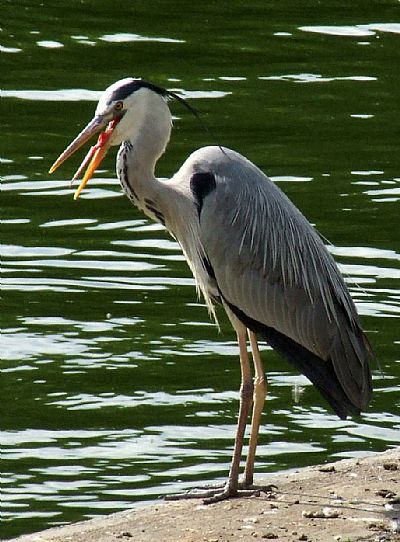
A heron feeling the heat! (photo taken in London).
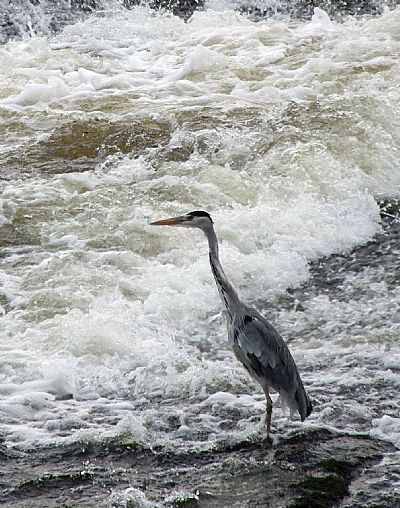
A heron in rushing water waiting for the opportunity to spear a fish. (Photo taken near Dumfries).
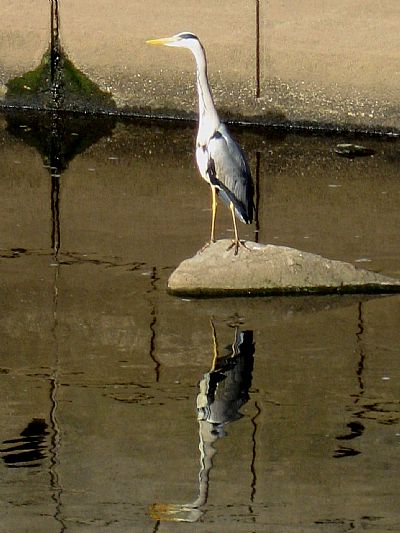
Heron self reflecting. (Paisley).
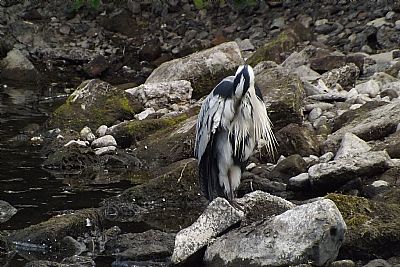
A heron preens itself quite intensively while also enjoying some sunshine early in the morning at the upper Leven.
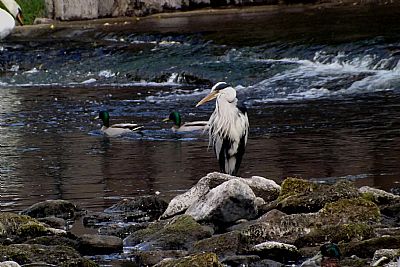
All done, for now. Two mallard drakes sail past in admiration.
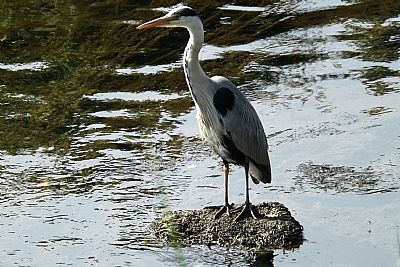
Contemplation on a rock at the bend in the River Leven near India Street.
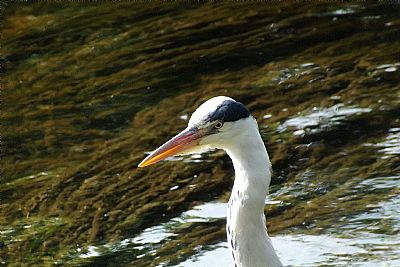
Elegance in the morning sunshine.
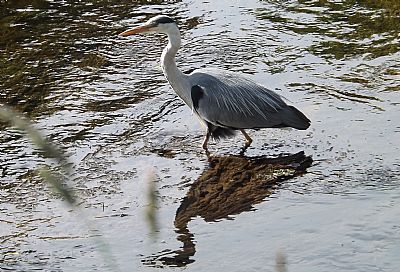
The heron and its shadow prowl in perfect tandem for small fish in the shallows. With patience and very slow movement, even standing quite still for ages, this can confuse the fish into false security in the shadow. A flash of the harpoon results in a tasty meal.
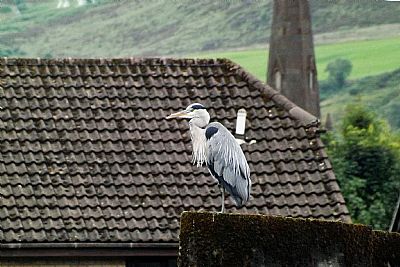
Watching the world go by from the top of one of the piers of the Leven barrage.
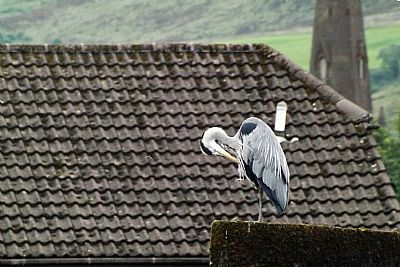
And while there is some privacy, some thorough preening.
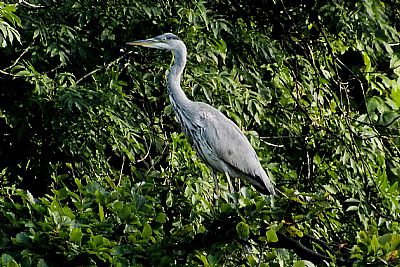
If you compare this heron to those in the picture above you will notice some differences. It does not have the black "shoulder" patches and has a streaky grey chest as compared to the almost white of the others. This means that it is fully grown, but still immature. The regular adult was seen a few hundred metres further downstream on the same day and is most probably its parent.
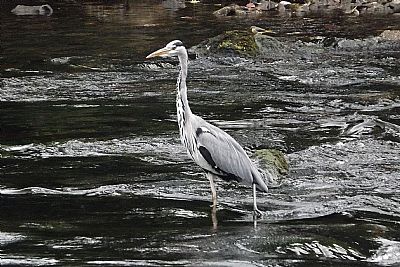
As it matures the shoulder patches become more pronounced.
Herons symbolize tranquility, serenity, elegance, and grace. They are most often found wading through shallow waters and calmly stalking their aquatic prey. They can be found in art through the ages including tapestries. The following is a photograph taken in the River Leven and then given a digital effect that is reminiscent of a tapestry.
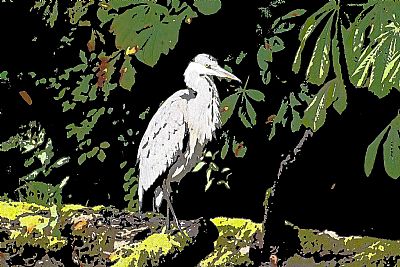
An adolescent heron not yet with fully formed distinctive black shoulders or "eyebrows". A photo edited to give an arts-&-crafts feel.
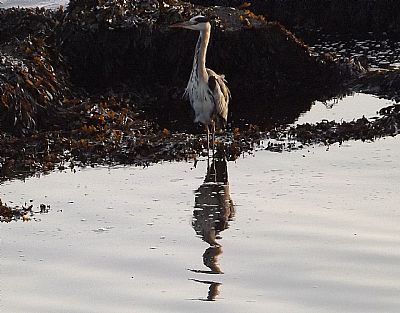
Herons generally prefer fresh water, perhaps because they find prey easier to catch in it, but they can be equally at home in the sea as this heron is at Craigendoran.
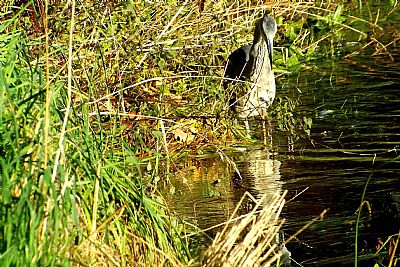
As the Leven subsides after it had burst its banks in October 2023, various small water creatures are found amongst the plants and a heron and its reflection stalk them for a meal.
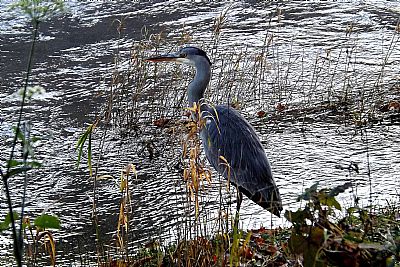
A crisp morning in November. Although seeming to mind its own business, this one became mobbed by gulls and carrion crows. Perhaps they wanted easy pickings of whatever it had caught; maybe a small fish.
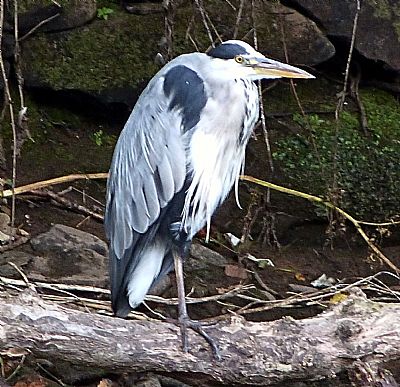
Mid-August. A heron deep in contemplation on one leg.
CANAL AND RIVER TRUST website : https://canalrivertrust.org.uk/things-to-do/canal-and-river-wildlife/a-spotters-guide-to-waterway-wildlife/heron-waterway-wildlife
GAME AND WILDLIFE CONSERVATION TRUST : https://www.gwct.org.uk/wildlife/species-of-the-month/2021/grey-heron/
RSPB : https://www.rspb.org.uk/birds-and-wildlife/wildlife-guides/bird-a-z/grey-heron/
SCOTTISH WILDLIFE TRUST : https://scottishwildlifetrust.org.uk/species/grey-heron/

